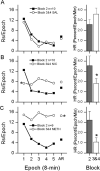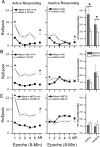Nicotine and methamphetamine disrupt habituation of sensory reinforcer effectiveness in male rats
- PMID: 24708147
- PMCID: PMC4083460
- DOI: 10.1037/a0034741
Nicotine and methamphetamine disrupt habituation of sensory reinforcer effectiveness in male rats
Abstract
The reinforcing effectiveness of a sensory stimulus such as light-onset rapidly habituates (Lloyd, Gancarz, Ashrafioun, Kausch, & Richards, 2012). According to memory-based theories, habituation occurs if a memory exists for perceived stimulation, and dishabituation occurs if a memory does not exist and the stimulation is "unexpected." According to Redgrave and Gurney (2006), unexpected response-contingent sensory stimuli increase phasic firing of dopamine neurons, providing a sensory error signal that reflects the difference between perceived and expected stimuli. Together, memory-based theories of habituation and the sensory error signal hypothesis predict a disruption (slowing) of habituation rate by novel response-contingent sensory stimulation or by artificial increases in dopamine neurotransmission by stimulant drugs. To test these predictions, we examined the effects of stimulant drugs on both the operant level of responding (snout-poking) and operant responding for a sensory reinforcer (light-onset) presented according to a fixed ratio 1 schedule. Robust within-session decreases in responding indicating habituation were observed. The effects of stimulant drugs (saline, n = 10; nicotine, 0.40 mg/kg, n = 10; and methamphetamine, 0.75 mg/kg, n = 9) on habituation in rats were determined. Nicotine was found to decrease habituation rate and did not affect response rate, while methamphetamine decreased habituation rate and increased response rate. In addition, introduction of a novel visual stimulus reinforcer decreased habituation rate and increased responding. These findings show that habituation of reinforcer effectiveness modulates operant responding for sensory reinforcers, and that stimulant drugs may disrupt normally occurring habituation of reinforcer effectiveness by increasing dopamine neurotransmission.
PsycINFO Database Record (c) 2014 APA, all rights reserved.
Figures



References
-
- Berlyne DE. Conflict, arousal, and curiosity. McGraw-Hill; New York, NY: 1960.
-
- Berlyne DE. The reward-value of indifferent stimulation. In: Tapp JT, editor. Reinforcement and behavior. Academic Press; New York, NY: 1969. pp. 179–214.
-
- Chiu VM, Schenk JO. Mechanism of action of methamphetamine within the catecholamine and serotonin areas of the central nervous system. Current Drug Abuse Reviews. 2012;5:227–242. - PubMed
Publication types
MeSH terms
Substances
Grants and funding
LinkOut - more resources
Full Text Sources
Other Literature Sources
Medical

